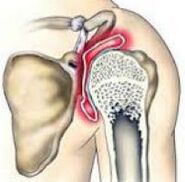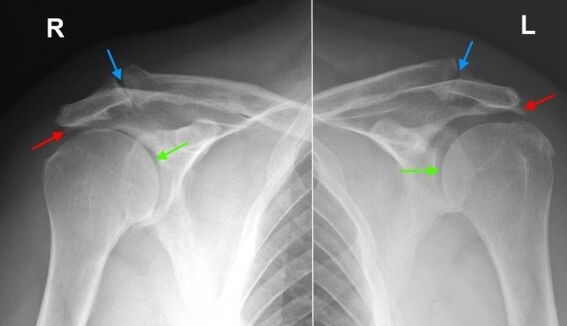Osteoarthritis of the shoulderIs chronic a disease in which the tissue of the articular cartilage is destroyed and thinned, pathological changes in the soft tissues occur, and bone growth forms in the area of the joint. It is manifested by pain and crunching in the affected area. In the later stages, the range of motion decreases. The pathology is chronic and gradually progresses. The diagnosis is made taking into account the clinical picture and radiological findings. Treatment is usually conservative: physical therapy, anti-inflammatory drugs, chondroprotectors, exercise therapy. If the joint is destroyed, an arthroplasty is done.
a disease in which the tissue of the articular cartilage is destroyed and thinned, pathological changes in the soft tissues occur, and bone growth forms in the area of the joint. It is manifested by pain and crunching in the affected area. In the later stages, the range of motion decreases. The pathology is chronic and gradually progresses. The diagnosis is made taking into account the clinical picture and radiological findings. Treatment is usually conservative: physical therapy, anti-inflammatory drugs, chondroprotectors, exercise therapy. If the joint is destroyed, an arthroplasty is done.
general information
Osteoarthritis of the shoulder joint is a chronic disease in which, as a result of degenerative-dystrophic processes, the cartilage and other tissues of the joint are gradually destroyed. Usually people aged 45 and over are affected by osteoarthritis, but in some cases (after injuries, inflammation) the disease can develop at a younger age. Pathology is equally common in women and men, more common in athletes and people who do heavy physical work.
The reasons
The starting point for changes in osteoarthritis of the shoulder joint can be both the normal aging process of tissues and damage to or disruption of the cartilage structure due to mechanical influences and various pathological processes. Primary osteoarthritis, as a rule, is detected in the elderly, secondary (developed against the background of other diseases) can occur at any age. The main reasons are considered to be:
- Development flaw.Pathology can be noted with underdevelopment of the humeral head or glenoid cavity, shoulder capomelia and other anomalies of the upper extremity.
- Traumatic injury.Osteoarthritis of traumatic etiology occurs most often after intra-articular fractures. A possible cause of the condition can be a shoulder dislocation, especially the usual one. Severe bruises are less likely to act as provocative injuries.
- Inflammatory processes.The disease can be diagnosed with long-term shoulder scapular periarthritis, previously suffered nonspecific purulent arthritis, and specific arthritis of the joint (including tuberculosis, syphilis, and a few other diseases).
Risk factors
Osteoarthritis is a polyetiological disease. There is a wide group of factors that increase the likelihood of this pathology:
- Hereditary disposition.Many patients have close relatives who also suffer from osteoarthritis, also in other locations (gonarthrosis, coxarthrosis, ankle arthrosis).
- Overuse of the joint.It can occur in volleyball players, tennis players, basketball players, throwers of sports equipment, as well as in people whose job involves constantly high stress on the hands (hammers, loaders).
- Other pathologies.Osteoarthritis is more commonly found in people with autoimmune diseases (rheumatoid arthritis), some endocrine and metabolic disorders, systemic connective tissue insufficiency, and excessive joint mobility.
The likelihood of developing the disease increases dramatically with age. Frequent hypothermia and unfavorable environmental conditions have a certain negative impact.
Pathogenesis
The main reason for the development of osteoarthritis of the shoulder joint is a change in the structure of the articular cartilage. The cartilage loses its smoothness and elasticity, and the gliding of the joint surfaces becomes more difficult when moving. Microtraumas occur, which lead to a further deterioration in the condition of the cartilage tissue. Small pieces of cartilage detach from the surface and form exposed joint bodies that also injure the inner surface of the joint.
Over time, the capsule and synovium thicken, areas of fibrous degeneration appear in them. Due to thinning and loss of elasticity, the cartilage no longer provides the necessary shock absorption, so the load on the underlying bone increases. The bone deforms and grows along the edges. The normal configuration of the joint is disturbed, there are restrictions on movement.
classification
In traumatology and orthopedics, a three-tier systematization is mostly used, which reflects the severity of the pathological changes and symptoms of osteoarthritis of the shoulder joint. This approach allows you to choose the optimal medical tactic, taking into account the severity of the process. A distinction is made between the following stages:
- The first- there are no major changes in the cartilage tissue. The composition of the synovial fluid changes and the nutrition of the cartilage is impaired. Cartilage does not tolerate stress, so joint pain (arthralgia) occurs from time to time.
- The second- the cartilage tissue begins to thin, its structure changes, the surface loses smoothness, cysts and calcifications appear in the depths of the cartilage. The underlying bone is slightly deformed, and bone growths appear along the edges of the joint platform. The pain becomes permanent.
- third- Pronounced thinning and destruction of the cartilage structure with extensive areas of destruction. The articulating platform is deformed. Uncovered restriction of movement, weakness of the ligamentous apparatus and atrophy of the periarticular muscles.
Symptoms
In the early stages, patients with osteoarthritis worry about discomfort or slight pain in the shoulder joint when exposed to stress and certain body positions. Crunching may occur during movement. The joint is not changed externally, there is no edema. Then the intensity of pain increases, arthralgia becomes a habit, occurs constantly and occurs not only during exercise, but also at rest, even at night. Peculiarities of the pain syndrome:
- Many patients note the dependence of the pain syndrome on weather conditions.
- Along with aching pain, muscle soreness develops over time with physical exertion.
- Pain can only occur in the shoulder joint, radiate into the elbow joint or spread over the entire arm. Possible back and neck pain on the affected side.
After a while, patients notice noticeable morning stiffness in the joint. The range of motion decreases. Slight swelling of the soft tissues is possible after physical exertion or hypothermia. As the osteoarthritis progresses, the movements become more and more restricted, contractures develop and the function of the extremities is severely impaired.
diagnosis
The diagnosis is made by an orthopedic surgeon taking into account the characteristic clinical and radiological signs of osteoarthritis of the shoulder joint. If you suspect secondary osteoarthritis, contact a surgeon, endocrinologist. The joint is not changed at first, later it is sometimes deformed or enlarged. The pain is noted on palpation. Movement restrictions can be recognized. To confirm osteoarthritis, the following is recommended:
- X-ray of the shoulder joint.Dystrophic changes and marginal bone growths (osteophytes) are found, in later stages joint space narrowing, deformations and structural changes in the underlying bone are found. The joint space can assume a wedge-shaped shape, osteosclerotic changes and cystic formations are visible in the bone.
- Tomographic research.When in doubt, especially in the early stages of the disease, a CT scan of the shoulder joint is performed to obtain additional data on the condition of the bone and cartilage. If there is a need to assess the condition of soft tissues, magnetic resonance imaging is done.
Differential diagnosis
The differential diagnosis of osteoarthritis is made in gout, psoriasis, rheumatoid and reactive arthritis, and in pyrophosphate arthropathy. In arthritis, a blood test will show signs of inflammation; Changes on the X-rays are not very pronounced, osteophytes are absent, there are no signs of deformation of the articular surfaces.
In psoriatic arthritis, in addition to joint manifestations, rashes are often found. In rheumatoid arthritis, a positive rheumatoid factor is determined. In pyrophosphate arthropathy and gouty arthritis, the biochemical blood test shows corresponding changes (increase in uric acid salts, etc. ).

Treatment of osteoarthritis of the shoulder
The patients are under the supervision of an orthopedic surgeon. It is necessary to limit the load on the arm, excluding sudden movements, lifting and prolonged weight carrying. At the same time, it should be remembered that inaction also has a negative effect on the diseased joint. In order to keep the muscles in a normal state and restore the shoulder joint, you need to regularly conduct the exercise therapy complex recommended by the doctor.
Conservative treatment
One of the most urgent tasks in osteoarthritis is the fight against pain. To eliminate pain and reduce inflammation, the following are prescribed:
- Medicines with general effects.NSAIDs are prescribed in tablet form during an exacerbation. If used uncontrolled, they can irritate the stomach wall, negatively affect the condition of the liver and the metabolism in the cartilage tissue, so they are only taken as directed by a doctor.
- Local remedies.NSAIDs are often used in the form of gels and ointments. Self-administration is possible if symptoms appear or worsen. Topical hormone preparations, which should be used on the recommendation of a doctor, are less frequently indicated.
- Hormones for intra-articular administration.In the presence of severe pain syndrome that cannot be eliminated by other methods, intra-articular administration of drugs (triamcinolone, hydrocortisone, etc. ) is carried out. Blockages are carried out a maximum of 4 times a year.
To restore and strengthen cartilage in stages 1 and 2 of osteoarthritis, funds from the group of chondroprotectors are used - drugs that contain hyaluronic acid, chondroitin sulfate and glucosamine. The courses of treatment are long (from 6 months to a year or more) and the effects are noticeable after 3 months or more.
Physiotherapy treatment
With osteoarthritis of the shoulder joint, massage, physiotherapeutic exercises and physiotherapeutic techniques are actively used. During the remission period, patients are referred for spa treatment. Apply:
- Mud therapy and paraffin;
- medicinal baths;
- Magnetic Therapy and Infrared Laser Therapy;
- Ultrasonic.
surgery
In stage 3 of the disease with considerable cartilage destruction, restricted mobility and disability, a joint replacement is carried out. The referral for surgery is made taking into account the patient's age, activity level and the presence of severe chronic diseases. By using modern ceramic, plastic and metal endoprostheses, you can completely restore the function of the joint. The service life of prostheses is 15 years or more.
forecast
Osteoarthritis is a long-term, gradually progressive disease. It cannot be completely cured, however, it is possible to significantly slow down the development of pathological changes in the joint in order to maintain the ability to work and a high quality of life. To get the maximum effect, the patient must take their disease seriously and be ready to follow the doctor's recommendations even during the period of remission.
prophylaxis
Preventive measures include reducing household violations, adhering to industrial safety, eliminating excessive loads on the shoulder joint during work and sports. It is necessary to timely diagnose and treat pathologies that can provoke the development of arthritic changes.





































